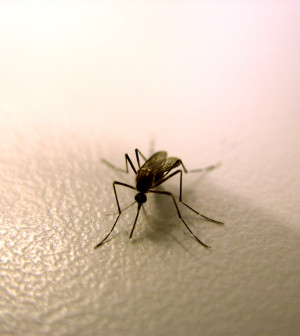- Navigating Your Midlife Crisis: Embracing New Possibilities
- City Raccoons Showing Signs of Domestication
- Mapping the Exposome: Science Broadens Focus to Environmental Disease Triggers
- One Week Less on Social Media Linked to Better Mental Health
- Your Brain Changes in Stages as You Age, Study Finds
- Some Suicide Victims Show No Typical Warning Signs, Study Finds
- ByHeart Formula Faces Lawsuits After Babies Sickened With Botulism
- Switch to Vegan Diet Could Cut Your Greenhouse Gas Emissions in Half
- Regular Bedtime Does Wonders for Blood Pressure
- Dining Alone Could Mean Worse Nutrition for Seniors
Malaria Vaccine Protection Short-Lived in Young Children

The world’s most promising malaria vaccine appears to offer short-lived protection, fading away within a matter of years, a new clinical trial reveals.
Even worse, the vaccine — dubbed RTS,S/AS01 — might increase children’s long-term risk of contracting malaria if they live in a region with heavy transmission of the mosquito-borne parasite, the researchers found.
The vaccine can “lead to a situation where unvaccinated children have more natural immunity than vaccinated children, and therefore get less malaria,” said senior researcher Philip Bejon. He’s director of the Kenya Medical Research Institute-Wellcome Trust Program in Kilifi, Kenya.
The results indicate that RTS,S/AS01 could have limited usefulness in the global fight to eradicate malaria, said malaria expert Dr. Christopher Plowe, a professor of medicine with the University of Maryland School of Medicine.
“There could be places where it will be beneficial, but we need a vaccine that’s going to be beneficial everywhere,” Plowe said. “Nobody is satisfied with a vaccine that can only be used under very specific circumstances.”
But the vaccine’s maker, GlaxoSmithKline, contends that the children in this particular clinical trial may not have been given enough doses of RTS,S/AS01. GlaxoSmithKline partially funded the current study.
“It is important to highlight that this follow-up study was conducted without a fourth vaccine dose, which is now considered the preferred regimen for implementation of RTS,S,” a statement from the company said.
“A large-phase III trial of the vaccine conducted in seven countries showed that children who received four doses of RTS,S were protected against malaria for at least four years,” the company said.
In 2015, an estimated 214 million people contracted malaria all over the world. More than 438,000 people died from the disease, according to the U.S. Centers for Disease Control and Prevention. Most cases occur in sub-Saharan Africa.
People with the illness often suffer fever, chills, sweats, nausea, and an aching head and body, the CDC says. Severe cases can result in acute respiratory distress syndrome, anemia, kidney failure and other life-threatening symptoms.
RTS,S/AS01 triggers the body’s immune response against Plasmodium falciparum. P. falciparum is the world’s most deadly malaria parasite, according to the World Health Organization.
The vaccine is designed to prevent the parasite from gaining a foothold in a person’s liver, according to GlaxoSmithKline. If the parasite multiplies in the liver, it gets into the bloodstream and brings about a full-fledged case of malaria.
In this trial, 447 children were randomly assigned to receive three doses of either the malaria vaccine or a rabies vaccine that served as a control. The children, from Kenya and Tanzania, were between 5 months and 17 months old.
The vaccine had a protection rate of about 36 percent in the first year. But, by the fourth year protection had fallen to about 2.5 percent, the results showed.
In the fifth year, the researchers found the overall protection rate was negative. But that finding was driven solely by the vaccine’s performance in areas where there is high exposure to malaria.
This “rebound” effect might have happened because the vaccine prevents early exposure to malaria in the liver, which normally may allow a person to develop some natural immunity to the parasite, Plowe suggested.
“You’re basically temporarily reducing exposure to malaria, so you build up less natural immunity,” he said. “When the vaccine wears off, you don’t have the vaccine and you don’t have the natural immunity that would have built up without a vaccine.”
Bejon said that RTS,S/AS01 still might prove useful as a four-dose vaccine.
“I think this, in combination with the phase III data, means that a three-dose regimen couldn’t be recommended, but a four-dose regimen is still worth further evaluation,” he said.
GlaxoSmithKline said it’s working with the World Health Organization “on a pilot implementation program with RTS,S to better understand the feasibility of administrating a four-dose schedule of the vaccine in a real-world setting, the potential impact of RTS,S when it comes to saving lives, and continue safety monitoring of the vaccine.”
The vaccine still could help protect kids in places where there is low exposure to malaria, Plowe added. In those areas, the vaccine waned but still maintained an overall 26 percent effectiveness against malaria, the study showed.
There are about 20 different malaria vaccine candidates under investigation right now, said Dr. Amesh Adalja. He’s a senior associate at the University of Pittsburgh’s UPMC Center for Health Security in Baltimore.
“Hopefully these approaches will prove more effective, as malaria continues to kill hundreds of thousands yearly,” Adalja said.
“It is disappointing that the RTS,S malaria vaccine had a major drop-off in efficacy . . . especially in areas with high malaria burden,” he noted.
One new approach involves adding additional malaria proteins to the RTS,S vaccine, to improve its potential effectiveness, Plowe said. Another involves infecting mosquitoes with malaria and then irradiating them, creating a weakened strain of malaria that can be used as a “live” vaccine.
“The weakened parasites are purified out of the mosquitoes and frozen, and that’s actually the vaccine,” Plowe said.
The study was published June 30 in the New England Journal of Medicine.
More information
For more on malaria, visit the U.S. Centers for Disease Control and Prevention.
Source: HealthDay
Copyright © 2025 HealthDay. All rights reserved.










